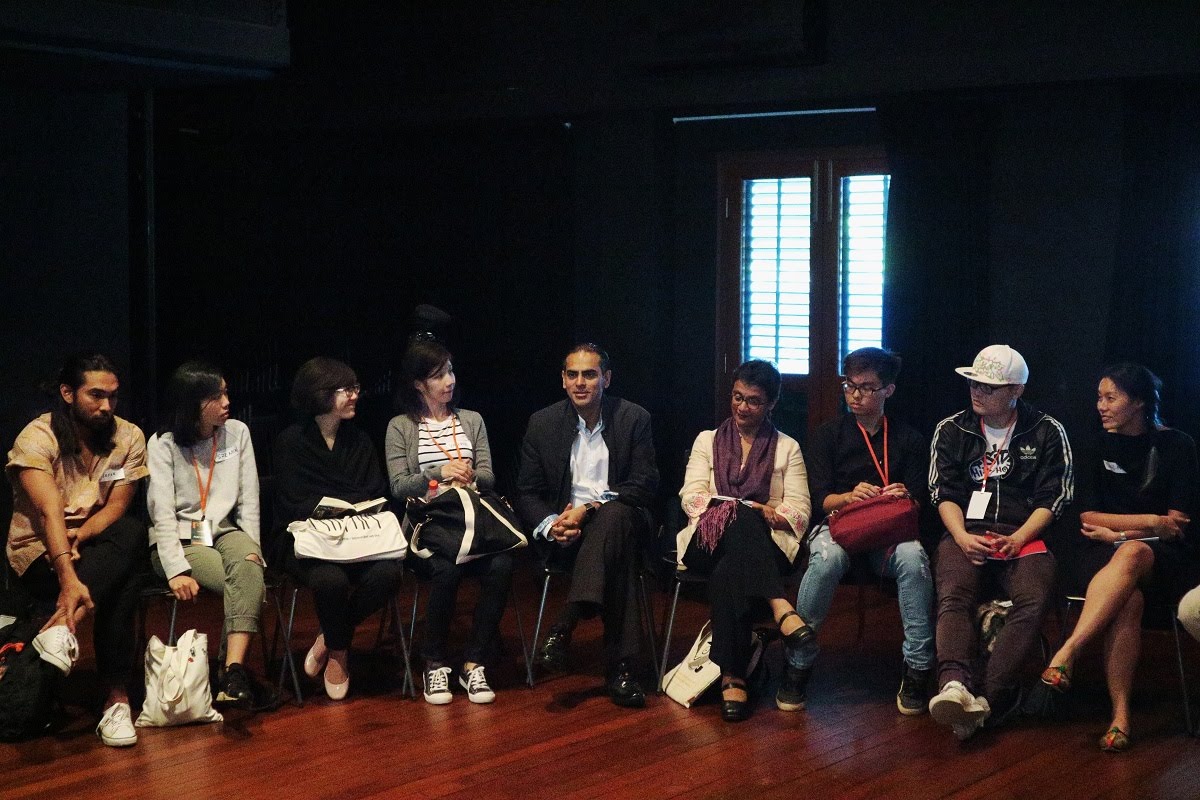Participants attended an introductory briefing with the lead facilitators of POV 2018, Charlene Rajendran and Lim How Ngean, as well as SIFA's festival director Gaurav Kripalani.

Day 1 Activities:
- Programme Introduction
- P/W Workshop 1
- SIFA Performance: Octavia E. Butler’s Parable of the Sower
“A sower went out to sow her seeds,” sang Toshi Reagon at one point during Octavia E. Butler's Parable of the Sower, as she referenced the eponymous biblical story. The performance was staged as part of the Singapore International Festival of Arts (SIFA), and all the participants and facilitators of Points of View (POV) 2018 had gathered at Victoria Theatre to watch it at the end of the first day of the programme. As Reagon’s line of lyric was repeated and amplified by the rest of the ensemble, it became apparent that it was actually quite an apt way to describe what POV hopes to achieve.
During the programme briefing at Centre 42 at the start of the day, co-director of the Asian Dramaturgs' Network (ADN) Charlene Rajendran mentioned that “the role of someone who is willing to reflect and interrogate [performances] is a shrinking role that [POV] is trying to enlarge”. She suggested that critics - in both the casual and professional sense - are often expected to either say that they enjoyed a performance, or else hold their tongue, “because if you say anything [otherwise], you might ‘damage [the artists’] creative spirit’”. By creating a space for participants to reflect and discourse, POV strives to become a platform where we cultivate a group of performance writers and makers who are willing to approach and engage with works with a deeper sense of criticality.
Gaurav Kripalani, the festival director of SIFA 2018, likewise expounded on the importance of having more critical dialogue and writings within the arts industry in Singapore during his introductory address to the POV participants. “[When the show is over], what’s left is the review,” he said. “The review becomes a historical record, so having good critique is vital.”
And so, while lead facilitator of the Performance Writing (P/W) track Lim How Ngean stressed that he will be covering many forms of writing in the coming days, the review was a good place to begin.
In the first P/W workshop, which took place after the briefing, participants started off watching a live theatre review editing demonstration by arts writer/editor Corrie Tan. Through this exercise, Tan illustrated some common issues she would come across when editing reviews, and participants had the opportunity to peek into an editor’s mind and process. Some of the advice Tan and Lim gave participants when it comes to review writing include:
- Be careful with tenses in the review - it is acceptable to use either the past or present tense, as long as it’s consistent throughout (unless the publication stipulates a particular tense).
- Avoid making sweeping statements, and elaborate on points or terms that readers may not be familiar with.
- While there is sometimes a burden on reviewers to make sense of a piece, a review will generally not sound “stupid” as long as the writer has done his or her research, and responds to what he or she experienced.
- Try not to read reviews by other writers in advance, so that their opinions and language will not become an influence. Instead, feature articles or interviews with the director can serve as useful research in terms of providing context for the work.

Arts writer/editor Corrie Tan and Lim How Ngean discussed the difference between opinions and observations with Performance Writing participants in the first workshop of the programme.
The participants and facilitators then delved into a discussion of Robert Icke and Duncan Macmillan’s stage adaptation of 1984, another SIFA show that participants had watched together last week.
Participant Amanda Leong suggested that “what drove the performance was a sense of space”, citing how the set physically opened up as the play progressed.
“It was sleek and polished, but came across as being over-rehearsed, and it just wasn’t convincing. So all you end up noticing are things like, the technology is damn good!” shared Teo Xiao Ting with a laugh.
These were all salient points that could be made in a review, but to go further, Lim, Tan, and the participants then considered the idea of opinions versus observations.
“Sometimes when you go in to watch something, it really does pay to just make observations,” said Lim. “For example, the strobe lights in 1984. Everyone noticed that, but how many times did they go on and off? Because those are the things that are quantifiable, and can be used to argue a certain point of view.”
This is a point that stuck with many of the participants after the workshop.
“My takeaway [from that session] is to check the habit or the urge to make quick judgements after watching a performance,” said Akanksha Raja. “It's important to take note of my observations first before jumping to opinions.”
The participants will gather again the following day for another workshop, this time to unpack Octavia E. Butler's Parable of the Sower.
To bring it back to the introductory meeting, Tan said that “what we don’t have in Singapore is someone with a sustained voice in the industry for more than six or ten years. My hope is that we will have a pool of people who stay the course.”
While not all P/W participants will necessarily go on to become arts writers - just as not all seeds end up on good soil in the biblical Parable of the Sower - this first day of POV was certainly a good start.
Published: 5 May 2018